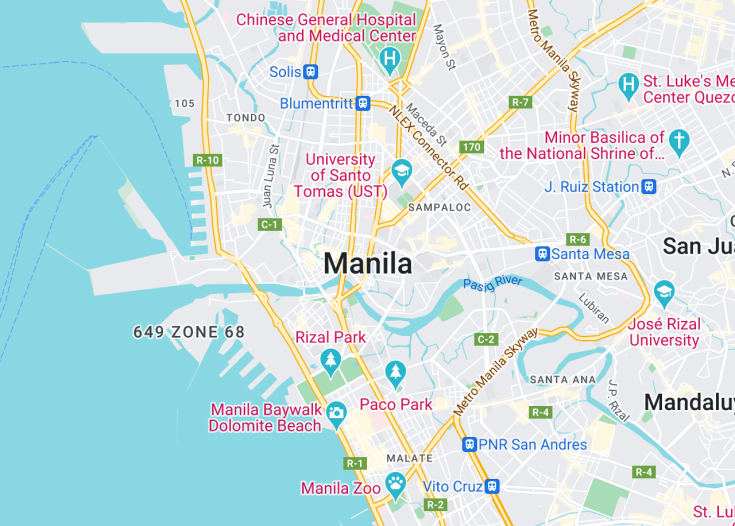Manila, the vibrant capital of the Philippines, serves as the heart of the nation’s socio-economic and cultural life. Known for its historical richness, including Intramuros, a fortified area established in the 16th century, Manila offers a unique blend of the old and new. The city is teeming with bustling markets, grand colonial architectures, and modern innovations. Its strategic location on Manila Bay enhances its appeal, providing picturesque sunsets that have captivated both locals and tourists alike. A diverse city with a complex history, Manila is a compelling destination offering a multitude of cultural, historical, and culinary experiences.
When in Manila, make time to visit the National Museum complex for a deep dive into the country’s history and culture. It’s a profoundly enlightening experience that shouldn’t be missed.
Explore the bay area and consider a sunset cruise. Manila Bay is famous for its views, and experiencing it from the water is truly magical.
Top things to do & see in Manila
Select the following sights and activities to discover best tickets and tours available in Manila.
Manila: The Pearl of the Orient
| Country | Philippines |
| Time in Manila | GMT+8 |
| Language spoken | Filipino (Tagalog) |
| Population | 1.78 million (as of 2020, by PSA) |
| Currency | Philippine Peso (₱, PHP) |
| Airports | Ninoy Aquino International Airport (7 mi / 11 km). |
Manila, the capital city of the Philippines, is a sprawling metropolis that is rich in history and cultural heritage. Known officially as the City of Manila, it has a vibrant atmosphere that mixes the old and the new in intriguing ways. The city has seen centuries of colonial rule, which have left indelible marks on its architecture, food, and daily life.
Where is Manila?
Manila is located on the eastern shores of Manila Bay in the northern part of the Philippines’ island of Luzon.
Distances:
| Route | Distance by car | Time by car |
|---|---|---|
| Quezon City to Manila | 14 miles | 40 mins |
| Caloocan to Manila | 8 miles | 30 mins |
| Makati to Manila | 6 miles | 25 mins |
What is Manila famous for?
Manila is famous for its historical sites, such as Intramuros, the walled city that dates back to Spanish colonial times. The city is also known for its vibrant festivals, diverse cuisine, and bustling street life.
History
Pre-Hispanic Period (Before 1571)
The area now known as Manila has been inhabited since prehistoric times. The earliest evidence suggests the presence of life from around the year 3000 BCE. Manila eventually became a thriving coastal settlement and trading post ruled over by several local rajahs. Notably, it was part of the Bruneian Empire and had extensive relations with other parts of Southeast Asia.
Spanish Colonization (1571-1898)
Manila’s modern history began when Spanish navigator Miguel López de Legazpi declared it a city and established it as the capital of the Spanish East Indies in 1571. The city was a pivotal center of political, religious, and economic activity in Asia. The Manila Galleon trade, which linked Asia with Acapulco in the Americas, brought immense wealth. The period also saw the construction of Manila’s iconic Intramuros, a fortified district which remains a historical landmark.
American Period (1898-1946)
The Spanish-American War ended Spanish rule, and the Treaty of Paris of 1898 handed the Philippines to the United States. During American colonization, Manila saw significant urban development including the introduction of public education, a modern water system, and improvements in public health. World War II significantly affected Manila, leading to its declaration as an open city to prevent destruction; however, the Battle of Manila in 1945 resulted in catastrophic damage.
Post-War and Modern Era (1946-Present)
Following its liberation from Japanese occupation, Manila underwent extensive reconstruction. It was named the capital of the newly independent Republic of the Philippines in 1946. Throughout the decades, Manila faced challenges such as political instability, population growth, and urban congestion. Today, it serves as the nation’s cultural, economic, education, and governmental heart, continuously evolving and striving towards modernization while grappling with issues typical of a bustling metropolis.
Visit Manila
What to see and do in Manila
Explore the rich historical and cultural tapestry of Manila. Visit Intramuros, the walled city that houses centuries-old churches like San Agustin and Manila Cathedral. Don’t miss Rizal Park, a historical landmark where the national hero, Dr. Jose Rizal was executed. For museum enthusiasts, the National Museum of the Philippines offers extensive collections of artifacts that showcase the Philippines’ cultural heritage. Additionally, enjoy shopping at Binondo, the world’s oldest Chinatown.
Annual Festivities in Manila
Manila hosts vibrant events throughout the year. The Feast of the Black Nazarene every January draws millions of devotees. Manila Day, which commemorates the city’s founding on June 24, is marked by citywide celebrations and events. The Manila International Book Fair, held in September, is a must for book lovers.
Best time to visit Manila
The best time to visit Manila is during the dry season from December to February when the weather is cooler and more comfortable for exploring the city. The rainy season from June to November can see heavy showers affecting travel plans.
Is Manila worth visiting?
Manila offers a compelling blend of the historical and the modern, reflecting its rich past alongside its evolving urban fabric. While the city is not without its challenges, including traffic and urban density, its cultural depth, historical landmarks, and vibrant festivals make it a fascinating destination. Visitors who appreciate rich history intertwined with energetic urban life will find Manila rewarding. Nonetheless, it’s advisable to plan for logistical challenges to make the most of your visit.









